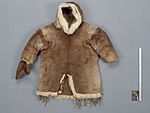qulittaq (Outer Parka)
About this object
History of use
Coats of this type with a slit in the front were worn towards the end of the 19th century and in the 20th century by the Nunatsiarmiut of Baffin Island. This coat was worn by boys, over an inner coat.
Narrative
Pierce donated this collection to the UBC Geology Museum in 1932, from which it transferred to the newly-opened Museum of Anthropology in 1948. Michell Pierce put together this collection of examples of Copper Inuit clothing and implements, while working in the area for the Hudson’s Bay Company. Before going to the area, he interviewed Dean Brock and M.Y. Williams about the possibility of collecting for UBC while there. This was the second collection he assembled, as the first was lost when the ship carrying the materials was caught in the ice.
Iconographic meaning
Historically fringes were not allowed near the sea because they would remind Sedna, the sea goddess of her lost fingers.
Physical description
Boy's outer coat, or parka, of brown caribou fur. The coat has a rounded close fitting hood, the crown is slightly pointed. The coat is thigh length and has a slit in the middle of the front. The hood, bottom and split are trimmed with white caribou fur. Groups of fringes are attached to this white trim along the bottom. A brown fur mitt trimmed with a broad band of white fur is attached to the right sleeve. (Note: photo shows inner and outer coats together, A2.514-15.)
Categories
Materials
